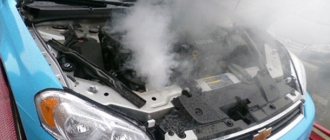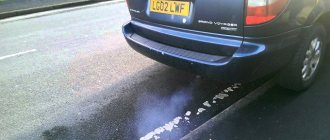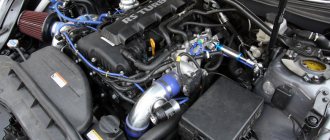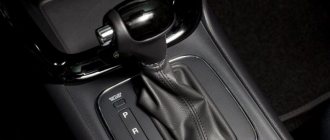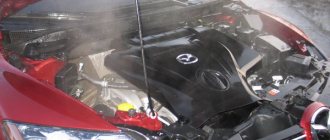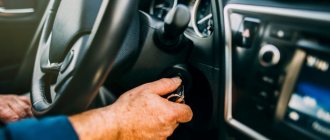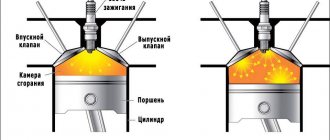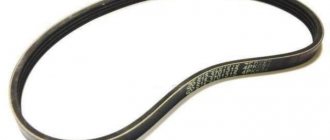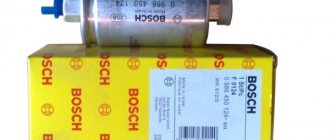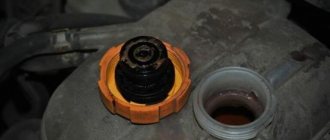It is difficult to imagine modern life without a car. It is a necessary means of transportation, which is why every year more and more “iron horses” appear on the roads and in yards.
Considering the poor quality of roads, the love of fast driving and the low consciousness of individual drivers, accidents on the roads occur with enviable regularity. According to statistics, road transport is the most dangerous means of transportation. More than 1 million people die each year worldwide due to road accidents.
1) Violation of traffic rules
Ignorance and disregard of traffic rules is the most common cause of car collisions, collisions with pedestrians and other incidents.
Often the rules are violated not only by drivers, but also by pedestrians, who because of this usually suffer much more than motorists who are protected at least by the body of the car.
What are the main causes and conditions of road accidents? Watch the video:
According to statistics, the following violations are most often committed:
- exceeding the speed limit: no more than 60 km/h in cities and 90 km/h on the highway (110 km/h on the highway);
- failure to comply with traffic regulations at intersections;
- violation of the rules when turning;
(Especially often, drivers forget to turn on the turn signal before the maneuver and make sure it is safe to drive using the mirrors).
What punishment does a driver face when driving under a “brick” sign? See here.
- the worst head-on accidents occur due to drivers driving on the opposite side of the road and running a red traffic light;
- Some motorists, in violation of traffic rules, drive too close to the vehicle in front, which is why the rule violator has too little time to brake if a sudden stop is necessary.
Statistics on road accidents and the number of deaths as a result of accidents serve as additional confirmation that traffic rules are not just recommendations for drivers, but important rules that must be strictly followed.
Drunkenness
Many people know the joke that there are four types of cars to transport a drunk person: taxi, ambulance, police car and hearse. It would be funny if it weren't so sad.
Despite extensive propaganda about the inadmissibility of driving a car by a drunk driver, for some reason motorists stubbornly ignore this requirement.
Statistics
When talking about what are the main causes of road accidents, drunkenness should be mentioned first. Indeed, even in countries with a high level of prosperity, such as Germany, the USA, Canada and France, accidents involving drunk drivers occur very often. Approximately 35% of all road traffic accidents involve drivers drinking alcohol.
In Russia this figure is even higher. The share of such accidents reaches 45% of the total number of accidents.
Alcohol and reaction
Through many tests and studies, it has been proven that even after a couple of glasses of beer, the driver’s ability to react to force majeure traffic situations decreases. And what can we say about that stage of intoxication when a person loses his sense of reality. In this state, it seems to him that he is omnipotent and is able to prevent any accident. However, this is a false impression imposed precisely by alcoholic drinks.
Among other things, alcohol causes excessive sleepiness in a person. This is partly due to the fact that it is customary to drink alcohol in the evening, when fatigue has accumulated in the body.
Now imagine whether a half-asleep person with a slow reaction and an altered perception of reality will be able to effectively respond to a difficult traffic situation? Hardly. After all, for actions aimed at avoiding an accident, the driver, as a rule, has only a split second.
Punishment
It would be useful to remind you that a driver will be deprived of his license for driving while intoxicated. And in case of repeated identical violation, even criminal liability is provided. After all, everyone knows that a drunk driver endangers not only himself, but also everyone around him.
2) Presence of technical faults in the car
In second place in the ranking of causes of road accidents are various malfunctions in the car and sudden breakdowns that occur while driving.
The full list of defects, the presence of which is prohibited from driving a car, is indicated in the rules:
- first of all, these are faulty brakes;
- steering wheel play exceeding permissible limits;
- non-working sound and lighting equipment (non-blinking headlights, constantly triggered alarm, and so on);
- problems with the chassis.
Breakdowns very often happen unexpectedly. However, in most cases, accidents caused by this factor occur due to the carelessness of drivers.
Inattentiveness and carelessness while driving are the cause of accidents.
So you definitely need to undergo a timely technical inspection, and before leaving, check at least basic things: the condition of the wheels, the functionality of the headlights, etc.
Vehicle malfunctions
Statistically, there are relatively few road accidents due to technical malfunctions of vehicles , but their consequences are often quite serious. The greatest danger is posed by:
- violation of the tightness of the hydraulic, pneumatic or pneumatic-hydraulic brake drive;
- discrepancy between the efficiency of the braking system and state standards;
- exceeding the maximum permissible total steering play (for passenger cars, for example, no more than 10 degrees);
- the presence of movements of components and parts of the steering system that are not structurally provided for;
- malfunction of the power steering system;
- malfunction of external lighting devices;
- insufficient tire tread height for proper grip on the road surface;
- tire damage;
- violation of the tightness of the engine power supply system;
- malfunctions in the exhaust gas exhaust system.
3) The driver’s condition does not allow him to drive the car.
Of course, here we are primarily talking about drivers under the influence of alcohol or drugs, who get behind the wheel while being inappropriate.
There is no need to further prove the danger of driving in this condition. This is confirmed by statistics according to which a significant proportion of fatal accidents occur due to the fault of inappropriate drivers.
However, the possibility of sudden deterioration in health while driving cannot be discounted either. A person can lose consciousness and have an attack of chronic illness.
To minimize the likelihood of this, of course, you need to assess your health yourself before the trip and, in case of any problems, choose other modes of transport.
Drunk driving can also be dealt with, including by ordinary citizens. You cannot be indifferent to what is happening around you, and when you see an inappropriate person trying to get behind the wheel, stop his actions or at least report him to the competent authorities.
What to do if there is a disagreement?
Often there is no evidence of guilt of any participant in the accident, so to establish guilt it is necessary to go to court. The court may order an accident examination, which is designed to comprehensively assess the circumstances of the accident.
To do this, the immediate scene of the accident is studied, cars are checked, and documents drawn up by traffic police officers immediately after the accident are analyzed. Based on the results of the examination, a court decision is made.
Based on a court decision, the person responsible for the accident is held accountable depending on the severity of the damage caused to property or the health and life of people. If there is no need for a trial, then a fine is imposed by the traffic police.
4) External factor independent of a person
The fame of Russian roads and weather conditions has long spread far beyond the borders of our country. Domestic off-road conditions and terrible snowstorms are glorified in literature; many are familiar firsthand with Russian fogs on highways and icy roadways.
On the one hand, all this causes accidents, however, on the other hand, such incidents still less often lead to serious damage, because rarely does anyone drive at high speed in difficult weather conditions or through potholes.
Typical emergency situations on the roads, how to avoid accidents? Watch in this video:
However, unexpected obstacles pose a greater danger:
- individual potholes, because hitting one of them can suddenly throw the car into the oncoming lane;
- open sewer manholes;
- road work zones without posted warning signs;
- sometimes, even just a road that suddenly ends with a cliff.
In order to be able to notice these dangerous elements of the road in time, you should at least adhere to the speed limit and carefully monitor the road situation.
Adverse weather conditions: fog, ice, rain, snowfall
Difficult weather conditions lead to a decrease in viewing range, changes in vehicle behavior, an increase in braking distance and many other undesirable effects that can lead to an emergency.
Fog Hazards:
- Reduced viewing range.
- Distortion of the perception of the real distance to an object.
- Distortion of the entire spectrum of colors except red.
- It should be remembered that in foggy conditions, high beams are completely useless.
In case of ice, relevant advice would be:
- It is advisable to start moving as smoothly as possible, without slipping.
- Braking should also be smooth, without disengaging the clutch; when switching to a lower gear, it is recommended to avoid sudden jumps in engine speed.
- It is advisable to switch gears quickly but smoothly.
Hazards of heavy rain:
- Reduced visibility.
- Damage to road signs.
- Erosion of the road surface itself.
- Rain-related contamination of headlights, turn signals and brake lights.
- Reduced wheel adhesion to the road surface.
- Hydroplaning is the separation of one or more wheels from the road surface due to the formation of a layer of water between the tread and the road surface, which leads to an almost complete loss of controllability.
Factors provoking road accidents during snowfalls:
- Reduced visibility range.
- Reduced wheel adhesion to the road surface.
- A soft shoulder hidden by a layer of snow means skidding and subsequent capsizing is possible.
- Road surface defects, rails and other obstacles hidden by snow.
- Icing of headlights, brake lights, turn signals and windshield.
- Difficulty in choosing a safe speed and distance from other road users.
Other causes of accidents
Road traffic accidents can also be caused by the driver’s inexperience, or by returning to driving after a long break - for example, a driver’s license was obtained in advance, 7-8 years, or even more, before purchasing your own car. A driver's license obtained for a bribe also does not add to road safety. An unexpected deterioration in health and emergency conditions that occur during a driver’s trip are also highly likely to result in an accident.
5) Cyclists and motorcyclists
This category of people are also road users.
Is riding a scooter without a license allowed? Do I need to get a license to drive a scooter? Read the link.
At the same time, they pose the greatest danger in terms of accidents:
- cyclists, because they are difficult to notice, they can suddenly leave the roadway and do not always have an idea of the traffic rules;
- motorcyclists, since they very often exceed the speed limit and are also difficult to notice traffic participants.
To ensure that motorcyclists and cyclists do not create problems for surrounding drivers and do not become victims of accidents, because in the event of any accident they are in a more vulnerable position, two-wheeled vehicles must be equipped with all the necessary warning signs, which must be visible in the dark.
The owners of such vehicles themselves must be extremely careful and thoroughly follow the rules.
The human factor is one of the fundamental causes of road accidents. Photo: zero50x.myjino.ru
Contempt
Disrespect on the road is a common phenomenon, drivers driving expensive cars look down on owners of cheaper models, and both ignore motorcyclists, cyclists and pedestrians. Frequent causes of accidents due to disrespect for road users:
- driving through intersections not according to the rules, but according to the principle “whose car is cooler is first”;
- recklessness;
- “Unnoticed” motorcyclists, cyclists and pedestrians.
6) Public transport drivers
Over the past 10-15 years, minibus drivers have regularly been included in all collections of road accidents.
In pursuit of profit, drivers cut each other off, run red lights, and exceed the speed limit. Traffic congestion is caused by buses standing at stops in two right lanes at once.
Many minibus drivers are inexperienced drivers or deliberately ignore traffic regulations, sometimes reasonably believing that traffic police inspectors will not fine public transport so as not to create inconvenience for passengers.
Therefore, drivers who do not want to get into an accident should be more careful about passenger carriers.
Possible consequences
If a driver causes an accident, he may be held liable for 1 of 3 types of liability. Civil liability arises regardless of whether harm was caused to the life and health of people. In accordance with the provisions of Article 1079 of the Civil Code of the Russian Federation, the culprit of the incident must compensate for the damage caused. The obligation to compensate can be imposed on several persons at once - on the person who was driving and on the citizen who provided the transport. The owner of the car can avoid civil liability only if the car was stolen.
If the actions of a citizen cause a threat to traffic safety, as well as human life or health, the person responsible for the incident may be held administratively liable. In accordance with Article 12.24, for causing minor harm a fine of 2500-5000 rubles is imposed. or deprivation of rights for 1-1.5 years. If damage of moderate severity was caused, the amount of the penalty will increase to 10,000-25,000 rubles. The alternative may be deprivation of rights. A citizen will not be able to drive a car for 1.5-2 years. Clause 6 of the Rules for determining the severity of harm caused to human health states:
The severity of harm caused to human health is determined in medical institutions of the state health care system by a doctor - a forensic expert.
If the victim was seriously injured or died, the person responsible for the incident will be prosecuted. The punishment is fixed in Article 264 of the Criminal Code of the Russian Federation. It says:
Violation by a person driving a car, tram or other mechanical vehicle of the rules of the road or the operation of vehicles, resulting through negligence in causing serious harm to human health, is punishable by restriction of freedom for a term of up to three years, or by forced labor for a term of up to two years with imprisonment. the right to hold certain positions or engage in certain activities for a term of up to three years or without it, or by arrest for a term of up to six months, or imprisonment for a term of up to two years with deprivation of the right to hold certain positions or engage in certain activities for a term of up to three years or without such.
Being under the influence of alcohol at the time of the accident increases the severity of the punishment. In accordance with paragraph 2 of Article 264 of the Criminal Code of the Russian Federation, the driver will be subject to forced labor for up to 3 years or imprisoned for up to 4 years. If the actions of a citizen resulted in the death of a person, the duration of service will increase to 4-5 years. The alternative would be imprisonment for a term of up to 5-9 years. In all situations, the driver will be deprived of his right to drive a car for 3 years.
7) Abrupt change in traffic conditions
Sometimes accidents occur due to circumstances beyond a person’s control, and usually he can no longer influence the development of the situation.
How to protect a child in a car to reduce injuries in an accident? Details at the link.
Such incidents may include:
- falling of a tree or other object onto the roadway;
- explosion near the road, fire and other types of disasters;
- collision of vehicles ahead.
Force majeure occurs in all areas of life, including during traffic.
They are extremely difficult to predict, but they also become causes of accidents much less frequently than the factors listed above.
Road accident statistics. Photo: : transspot.ru
Types of accidents
There are several classifications of road accidents. For example, there is a division of road accidents according to the severity of the damage caused - with death, with harm to human health and with material damage. The overwhelming majority of accidents are related specifically to material damage, but in 2022 alone, more than 17 thousand people died as a result of road accidents in Russia, and more than 194 thousand people were seriously injured.
The main classification of road accidents is related to the characteristics of their occurrence, which are set out in the Traffic Rules. Types of accidents:
- A collision between two cars or a collision between a vehicle and a rolling stock. It can be caused by a technical malfunction of the car, a sudden stop by one of the drivers, or failure to maintain the required distance between two vehicles;
- Hitting an obstacle. The obstacle must be motionless; it can be absolutely any object, from a tree or pole to a road fence or house;
- Colliding with a stationary vehicle (as well as a trailer or semi-trailer);
- Rollover, vehicle overturn (if they are not caused by other types of accidents);
- Hitting a pedestrian. This includes cases where pedestrians were injured due to a load or other object falling from a vehicle;
- Hitting a cyclist;
- Hitting a horse-drawn vehicle. The latter refers to any draft animals, as well as the carts that they transport;
- Hitting animals, that is, any wild and domestic animals and birds. For such an incident to be considered a traffic accident, there must be property damage. That is, these animals must belong to someone;
- Other types of incidents. There are many types of road accidents that occur relatively rarely - derailment of a tram, falling loads or throwing foreign objects onto a person by a car wheel, hitting a suddenly appeared obstacle, passengers falling out of a moving car or falling from a motorcycle due to a sudden change in speed or trajectory traffic, hitting people who are not participants in the traffic.
Road accident statistics and simple tips on how to avoid getting into trouble
Recently, largely thanks to the measures taken by the authorities, the mortality rate in road accidents in Russia has been gradually decreasing.
So in 2016, 10 thousand people died in accidents, which is 12% less than the previous year. Over a ten-year period (2004-2013), road deaths decreased by 21.8%.
However, in just 2016, there were 90 thousand car accidents, so the statistics of road accidents still remains within alarming limits, and reducing the number of road accidents is a task of national importance.
In order to protect yourself as much as possible from accidents, you should keep the following in mind:
- Drivers should slow down when approaching pedestrian crossings, driving near schools and in residential areas;
- It is also worth slowing down when cars in adjacent rows slow down, even if the road situation does not require this at first glance;
- it is necessary to change tires on wheels on time, according to weather conditions;
- the distance between cars must be no less than the distance that the car will travel in 2 seconds (in good weather) and in 5 seconds (in severe weather conditions);
- While driving, you should not be distracted from driving the car by talking on your mobile phone, smoking, talking with passengers and other irritants;
- To avoid various troubles, it is recommended to install a DVR in the cabin.
Transport accidents occur all the time.
Unfortunately, Russia occupies one of the leading places in this sad ranking.
Therefore, all car owners should be careful on the roads so as not to add to the statistics of car accidents.
Rules of conduct in case of an accident without loss of life
All drivers involved in an accident have the opportunity to resolve the situation without involving traffic police officers, but subject to the following conditions:
- The maximum amount of damage caused is 100 thousand rubles (from June 2022). For residents of Moscow, St. Petersburg and their regions, a maximum of 400 thousand rubles is established when an accident is recorded by a video recorder. (At the time of writing, you can find out more accurate data based on changes in legislation , use the search);
- There must be no more than 2 participants in the accident;
- There were no casualties, including pedestrians and passengers;
- Both vehicles involved in the accident are insured by MTPL.
In such a situation, if there is no disagreement regarding the accident, drivers must independently draw up a European protocol. To do this, you should carefully fill out the form, which is most often attached to the MTPL policy or is issued in person on the day the insurance contract is issued.
However, there is a small nuance here. If a vehicle with a trailer is involved in an accident, the simplified procedure using the European protocol is not carried out.
In addition, according to the rules of behavior in case of a car accident, you should take care of witnesses and evidence (just in case). Write down or photograph the license plates of cars passing nearby, as well as public transport. Subsequently, their drivers can be called to testify.
Record on camera the position of the car and any damage received before you remove the car from the roadway. The following must be visible in the photo: braking distance, license plates of both cars, location of fragments or damaged elements.
If you have any comments about what is described in the protocol, do not sign it. Or you have the right to indicate what you disagree with. Never sign your name on a blank form. Blank spaces in the document should be crossed out to avoid subsequent additions.
Learn more about cases of transport accidents and your actions >>>
Lecture 5. Road accidents.
1. Transport accidents and their consequences.
Automobile accidents.
The peculiarity of car accidents is that 80% of the wounded die in the first 3 hours due to excessive blood loss. According to statistics, traffic accidents most often occur during rush hours, on holidays, and on the first and last days of vacations. The road is especially dangerous in winter. The winter months account for 60% of incidents throughout the year. Rain and fog also complicate the road situation and often cause road traffic accidents (RTA).
In order to prevent road accidents, road users are obliged to:
driver – follow the traffic rules; ensure the vehicle is in good technical condition; be wearing a seat belt; do not carry passengers who are not wearing seat belts; assess the road situation and take into account how other drivers and pedestrians may behave;
passenger – be wearing a seat belt; boarding and disembarking should be done from the sidewalk or curb after a complete stop; do not distract the driver from driving; do not open the doors while driving;
pedestrian – follow the traffic rules; move along the sidewalk, pedestrian path, roadside; outside populated areas, go towards the movement of vehicles; cross the roadway at pedestrian crossings; do not linger or stop unnecessarily on the roadway; wait for route vehicles at landing sites.
Accidents on public transport.
All passengers using the services of urban public transport are required to know and follow basic safety rules: do not enter or exit the vehicle until it has completely stopped; do not lean against doors, do not stick your head and hands out of windows; inside a tram, trolleybus and bus, try to hold on to the handrails in case of emergency braking (a reliable support point is the handrail above your head); stand facing the direction of movement in order to be able to notice the danger in advance and have time to react to it (from this position, in the event of a collision and braking, you will fall face forward, which is much safer than falling on your back); in the event of a collision and the inability to stay upright, try to group yourself while falling, cover your head with your hands and see the landing site.
Umbrellas, canes and other objects with sharp and protruding edges pose a certain threat in the event of sudden braking. It is unsafe to walk in moving vehicles instead of standing, holding onto the handrails, or to doze. In these cases, a person simply does not have time to react to the threat.
Any public transport, including electric ones, is a fire hazard. For this reason, after an accident, it is advisable to quickly leave the cabin and step away and move 10-15 m to the side. If exit doors are jammed or there is a traffic jam, use emergency exits. Don't wait until the situation becomes critical. Break windows, for which use any heavy objects at hand: a fire extinguisher located in the cabin, a brake shoe, a hard briefcase, etc.; as a last resort, knock out the glass with a strong kick to the corner of the window, hanging by your hands on the ceiling handrails. Before leaving, be sure to clear the window opening of any remaining glass.
If there is a burning smell, such measures should be considered mandatory, since passengers may not have time to stand in line leading to the active exit. In case of fire, a city trolleybus burns very quickly. In this case, protect your nose and mouth in advance with a scarf, sleeve or other material, if possible moistening it with any liquid.
In the event of a fire in the cabin, notify the driver, open the doors using the emergency opening, emergency exits or break a window. If there is a fire extinguisher in the cabin, take measures to eliminate the fire. Get out of the cabin outside, bending down, without touching the walls or metal parts.
In the event of an accident, if a live wire is damaged, the safest places on a tram or trolleybus are seats. In this case, it is better to lift your feet off the floor and not touch the walls and handrails. You should get out of the electric vehicle by jumping, with both feet forward at the same time, without touching the body, so as not to close the electrical circuit with your body.
Accidents in the subway.
Emergency and dangerous situations at stations, in tunnels, and subway cars arise as a result of collisions and derailments of trains, fires and explosions, destruction of supporting structures of escalators, detection of foreign objects in cars and at stations that can be classified as explosive, spontaneously combustible and toxic substances, as well as the fall of passengers and their belongings onto station tracks.
Danger zones in the metro:
turnstile – it is prohibited to: jump over the turnstile; go through the turnstile as a group.
escalator – it is prohibited: to run along the escalator; sit on the steps of the escalator and place things on the handrails; linger at the exit of the escalator and create a crush.
platform – it is prohibited: to go down on the metro tracks; go beyond the boundary line at the edge of the platform; come close to the car until it comes to a complete stop.
carriage – it is prohibited to: lean against the doors; prevent doors from opening and closing; open doors while driving and at stops.
In case of an emergency, for example a fire in a train carriage, a loudspeaker or megaphone is used to notify passengers at the station, and a train loudspeaker warning device is used on the train.
Evacuation from the station can be carried out by escalators or on arriving trains. Disembarkation of passengers on the stretch is carried out at the command of the locomotive crew, without panic, in compliance with personal safety measures. After exiting the cars, you must move through the tunnel in the indicated direction. In case of failure of the loudspeaker warning, passengers are informed by the locomotive crew in each carriage. Passengers are disembarked, as a rule, through the side doors of cars on one or both sides or through unlocked doors between cars, starting from the car closest to the station to which passengers will be directed. If a situation arises that threatens the safety of passengers in one or more cars, disembarkation is carried out first from them. In the event of damage to the tunnel lighting, the driver of the locomotive crew turns on the white headlights on the lead car and a spotlight towards the station where passengers are heading.
From the rules for using the subway.
If people and objects fall on the subway tracks, smoke, fire, or other dangerous situations arise, contact the station duty officer or the train driver using the “passenger-driver” system.
If you find forgotten, ownerless or suspicious things and objects in the subway or train carriage, immediately notify police officers, subway workers or the train driver.
For safety reasons, it is prohibited to transport: flammable, toxic, poisonous, explosive and foul-smelling substances; firearms; piercing and easily breakable objects and things without cases and proper packaging; animals and birds without cages and special containers (bags); long and bulky luggage.
Actions of passengers in case of a railway accident.
The main causes of accidents and disasters in railway transport are malfunctions of the track, rolling stock, signaling equipment, centralization and blocking, dispatcher errors, inattention and negligence of drivers. Most often, rolling stock derails, collisions, collisions with obstacles at crossings, fires and explosions directly in the cars.
Anyone traveling by rail needs to know that the safest places in the carriage are the compartment shelves located towards the direction of travel. In case of emergency braking or a train collision, you will only be pressed against the wall, while passengers from opposite shelves will fall to the floor. The last person to fall after a complete stop is the one lying on the top shelf in the direction of travel.
The greatest threat to passengers is posed by the first and last carriages of the train. The first one is crushed and thrown out of the way in a head-on collision. With the latter, the same thing happens in a collision from behind, only on an even more catastrophic scale, since, unlike the first, it is not buffered by the locomotive and the baggage car.
During your trip, please observe the following rules:
when the train is moving, do not open the outer doors, do not stand on the steps or lean out of the windows;
carefully place luggage on the overhead luggage racks and do not overload them with things or secure them so that during sudden braking you do not become a victim of your own suitcases or boxes;
do not remove the stop valve unless absolutely necessary; remember that even in the event of a fire, you cannot stop the train on a bridge, in a tunnel or in other places where evacuation will be difficult;
do not carry flammable, chemical or explosive substances with you;
do not connect household appliances to the car's electrical network;
if you smell burning rubber or see smoke, contact a conductor immediately;
in case of a real threat, immediately leave the carriage through the vestibule doors and emergency exits; as a last resort, knock out window panes with improvised objects (ladders - stepladders, hard briefcases - diplomats, tables and clothing shelves torn from their nests);
do not reach for the suitcases, throw them; your life is not worth the things in them.
In case of a crash or emergency braking, brace yourself so as not to fall. To do this, grab the handrails and press your feet against the wall or seat. The safest thing to do is to sit on the floor of the carriage. After the first blow, do not relax and keep all your muscles tense until it becomes completely clear that there will be no more movement.
A fire on a train is scary not because of the flames, but, first of all, because of the toxic combustion products of synthetic finishing materials. Poisoning occurs in a matter of minutes, and with intense combustion - seconds.
There are situations when a moving train cannot be stopped.
Actions of passengers in an air transport accident.
Aircraft accidents and catastrophes are possible for many reasons and lead to serious consequences. Accidents during takeoff and landing are those where there is hope of rescue, since they usually occur when the aircraft is still on the ground or not high above it, and its speed is relatively low. Moreover, they usually happen in the airport area. Where rescue teams and necessary equipment are available.
Unlike a car, an airplane, when it hits a stationary structure or any vehicle, usually does not stop, but rushes on. Therefore, passengers are not exposed to sudden impacts. An exception to this would be when an airplane collides with a mountain. In this case, the chances of salvation are scanty.
In other cases, if an emergency occurs during flight, the crew may decide to make an emergency landing. When preparing it, you must immediately clear the aisles and take your seats in your chairs, the backs of which should be brought to a vertical position. At the flight attendant’s command “Attention boarding,” you should lean forward, cover your head with soft things and place it on your hands, with which you clasp your knees. You need to remain in this position until the plane comes to a complete stop. After the plane stops, unfasten your seat belts and prepare to evacuate. When leaving the plane through the exit with the ladder extended and inflated, you need to jump onto it without stopping, but sit on the edge and then slide down. Only by jumping can an increase in evacuation speed be achieved.
To reduce or even avoid possible injuries during takeoff and landing accidents:
try to wear a coat or jacket made of materials that are difficult to ignite and difficult to melt;
think about what shoes you should wear; Avoid high-heeled shoes, but if you wear them and need to use an inflatable escape slide during evacuation, take them off when leaving the plane;
during each takeoff and landing, make sure that the seat belt is tightly tightened at your hips;
know what fixed position you need to take during an emergency landing; keep track of what is happening outside the plane; if everything indicates that an accident is inevitable, take the necessary position;
know where the exits are located on the plane and how they open.
During decompression, a rarefaction of air in the aircraft cabin as a result of depressurization, the latter is filled with dust and fog. Visibility decreases sharply, air quickly escapes from a person’s lungs and cannot be contained. Ringing in the ears and pain in the intestines may occur at the same time. Rapid decompression usually begins with a deafening roar (air escapes). In this case, without waiting for a command, immediately put on an oxygen mask. Do not try to help someone before you put on a mask yourself, even if it is your child: if you do not have time to help yourself and lose consciousness, you will both find yourself without oxygen. Immediately after putting on your mask, fasten your seat belts and prepare for a sharp descent.
If there is a fire on an airplane, remember that the greatest danger on board is smoke, not fire. Breathe only through cotton or woolen items of clothing, if possible, moistened with water.
A forced landing of an airplane on water is rare. Before sinking, the plane can float from 10 to 40 minutes. However, if the fuselage is damaged, this time is significantly shorter.
Airplanes with engines located on the wings will float in a horizontal position, while those with two or more engines on the tail will float tail-side down.
During splashdown, which is always unexpected, there is practically no time for preparation. In one case, the plane can touch the surface so smoothly that it is unclear whether it landed or splashed down; in another, it can fall apart and quickly sink. Therefore, when splashing down, it is necessary to act on the command of the crew commander or flight attendant.
Actions of passengers in case of a water transport accident.
Most major accidents and disasters on ships occur under the influence of hurricanes, storms, fog, ice, as well as through the fault of people - captains, pilots and crew members.
Abandoning a ship in the event of an accident or shipwreck is carried out only on the instructions of the captain. He gives such an order in the following cases:
there are clear signs of impending destruction of the vessel (dangerous list, entry into the water of the deck, stern, bow);
the ship remains afloat, but the spread of water throughout the ship leads to its flooding, and the crew does not have sufficient means to combat the water;
cargo displacement or icing occurs, which will ultimately lead to its capsizing, and the crew does not have the means to combat cargo displacement or icing;
a fire spreads throughout the ship, and the crew does not have the means to localize and extinguish it;
under the influence of wind, waves or currents, the vessel drifts onto reefs, where it can be broken or capsized; in this case, the ship does not move or is deprived of the ability to be steered and cannot counteract the force of nature, etc.
On large sea and river vessels, all actions related to self-rescue come down to the fastest possible exit to the boat deck and precise execution of the commands of the crew organizing rescue operations. When a boat alarm is declared, all collective means of rescue are brought into working position, and the crew prepares to abandon the ship.
If there are no life-saving equipment, while in the water, give signals with a whistle or raising your hand. Move as little as possible to stay warm. Heat loss in water occurs several times faster than in air, so movement even in warm water should be limited to just staying afloat. Wearing a life jacket to keep warm, tuck yourself together, wrap your arms around your chest at the sides and lift your hips higher so that less water washes over your groin area. This method will increase the estimated survival time in cold water by almost 50%. If you are not wearing a life jacket, look for something floating and grab onto it to make it easier to stay afloat until rescuers arrive. Rest lying on your back.
While on a life-saving craft. To conserve heat, stay closer to other victims and do physical exercise. Let us drink only to the sick and wounded. If there is no reasonable hope of reaching shore or entering the shipping lanes, try to remain close to other boats near the site of the wreck.
Keep your feet as dry as possible.
Lift and move them regularly to relieve swelling. Never drink sea water. Retain fluid in your body by cutting down on unnecessary movements. To reduce sweating, moisten your clothes during the day, and to reduce the temperature inside the raft, moisten its outer shell with water. Drink no more than 500-600 ml of water per day, dividing them into numerous small doses with the largest dose in the evening. Eat only emergency food supplies. Save smoke bombs until there is a real possibility that the signal you have given will be noticed. Do not use checkers all together in the hope of discovering yourself; entrust this to one person. Resource id #1224
Accident Prevention Measures
To reduce the number of road accidents, law enforcement agencies are taking the following measures:
- systematic work with drivers, which includes: issuing reminders on ignition safety when registering vehicles, increasing the level of qualifications, introducing innovations through the media, informing about deteriorating road conditions, and so on;
- carrying out preventive work with pedestrians. Familiarization of minors with traffic rules;
- increasing the level of training for novice drivers. Recently, requirements have increased not only for driver candidates, but also for educational institutions, as well as for passing the theoretical and practical parts of the exam;
- informing the population about the causes of road accidents. Conducting training to reduce emergency situations and eliminate serious consequences;
- improving the quality of road surfaces;
- introducing increased fines for serious offenses and tightening control over violations;
- introducing control over the movement of vehicles owned by legal entities: mandatory pre-trip and post-trip medical control, appointment of responsible persons for release onto the line, and so on;
- tightening requirements for technical inspection of vehicles and increasing mandatory technical inspection for certain categories of vehicles (for example, regular buses, minibuses);
- Carrying out control over the registration of motor vehicles and the import of cars from other countries.
Thus, the statistics of accidents on the roads of the Russian Federation is not reassuring. The number of accidents, although decreasing annually, is still at a fairly high level.
Traffic inspectors constantly monitor the situation on the roads using video cameras and patrol crews and take measures to reduce accidents.
What moral compensation is available in case of an accident with a child is described in the article: Accident with children. For information about responsibility for leaving the scene of an accident in a parking lot, see the page.
Find out what to do in 2022 if the culprit of an accident is without insurance.
Further actions
If you need the help of traffic police officers, you will have to wait for their arrival. Together with the inspector, an accident report is drawn up, and the traffic police officer records the testimony of all participants in the incident, and can also interview witnesses.
Drivers must receive copies of all documents drawn up from the inspector, since only if they are available can they count on compensation from the insurance company.
Traffic police officers perform different actions:
Often, car owners flee the scene of an accident, so the inspector’s duties include identifying signs of the car, after which the owner of the car is put on the wanted list.

